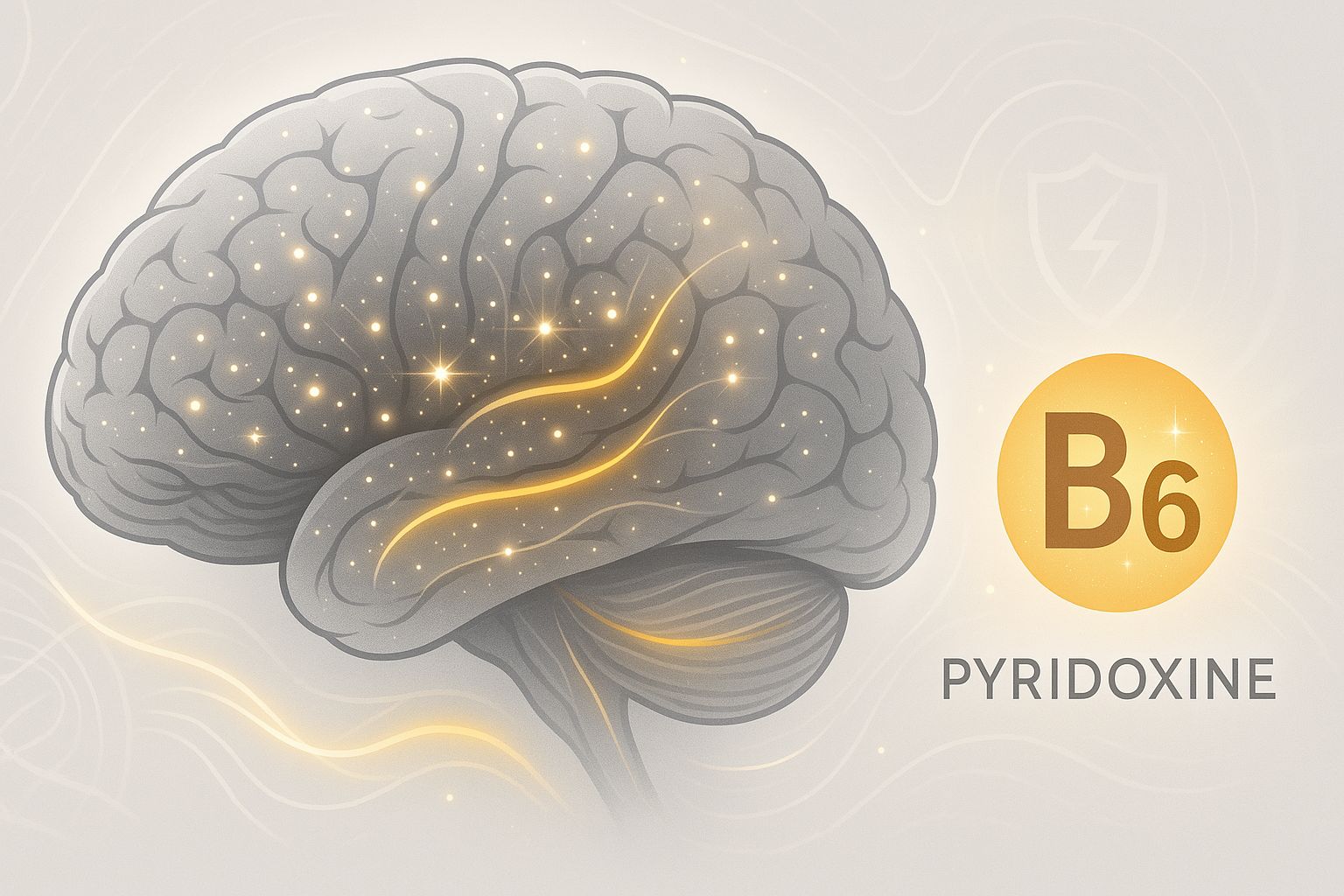Vitamin B6 and the nervous system - what are the relationships?

The brain is very fond of B vitamins. Vitamin B6 is one of those that affects the nervous system most strongly. It acts on neurotransmitters, regulates glucose, controls inflammatory processes and oxidative stress. There are a multitude of aspects with which vitamin B6 nurtures the nervous system and promotes well-being. Its adequate supply maintains normal physiological functions and reduces feelings of fatigue. In this article we will learn more about the properties of vitamin B6.
- Vitamin B6 and its importance for humans
- Vitamin B6's effects on the nervous system
- Vitamin B6 and neurotransmitters
- Vitamin B6 and prolactin
- Vitamin B6 and PMS
- Vitamin B6 and homocysteine
- Two forms of vitamin B6 - which one to choose?
- Safe doses of vitamin B6
Vitamin B6 and its importance for humans
Vitamin B6, or pyridoxine, is a versatile substance. Its biologically active form, or P5P (pyridoxal 5′-phosphate), is an essential cofactor in the function of more than 150 different enzymes. It participates in the metabolism of carbohydrates, lipids, amino acids and nucleic acids, and is involved in cell signaling. It is an efficient antioxidant and a compound with the ability to reduce levels of advanced glycation end products (AGEs).
The practical properties of vitamin B6 are many. Read on to learn about its effects on the brain and well-being.
Vitamin B6's effects on the nervous system
Vitamin B6 has a direct effect on immune system function and gene transcription/expression, and plays a role in regulating glucose levels in the brain. In this way, it works at the root - regulating inflammatory processes, energy supply to neurons and gene activity. However, there are more aspects of health for which pyridoxine is essential for maintenance.
Vitamin B6 and neurotransmitters
This vitamin is an essential cofactor in the production processes of many neurotransmitters, such as dopamine, norepinephrine, serotonin, γ-aminobutyric acid (GABA) and melatonin (sleep hormone). Its deficiency reduces their production to varying degrees. The most sensitive to the availability of vitamin B6 seem to be serotonin and GABA, which give us feelings of happiness and calm. Even mild B6 deficiency can noticeably slow down their production.
Vitamin B6 and prolactin
Once upon a time, animal studies showed that vitamin B6 deficiency causes an increase in prolactin. Since then, supplementing this vitamin has been seen as a tool to combat hyperprolactinemia. When studies show excess prolactin, a popular treatment is to use large doses of pyridoxine, on the order of up to 600 mg a day. Such treatment is included, among other things, alongside the use of drugs known to raise prolactin.
Vitamin B6 and PMS
Regular use of vitamin B6 is one of the ways with documented effectiveness for reducing the annoying symptoms of premenstrual syndrome. In a way, it connects to the previous point, because in a study its effectiveness was compared with bromocriptine, a drug used for hyperprolactinemia. After 3 months of taking 100 mg of pyridoxine daily, a significant reduction in PMS symptoms was noted. The effectiveness was similar to that of bromocriptine, but the tolerability of the treatment was much better - vitamin B6 did not produce the same side effects as bromocriptine.
Vitamin B6 and homocysteine
Homocysteine is one of the most important risk markers for cardiovascular disease, but it also has a major impact on the nervous system. Its excess, among other things, increases the risk of stroke and the severity of nervous system inflammation. Some data also show a correlation of high homocysteine levels with stronger depressive symptoms.
Vitamin B6 is essential for one of the pathways of homocysteine breakdown. It is a cofactor for the enzyme CBS, which converts homocysteine to cystathionine and then to cysteine and subsequent metabolites. This is the pathway that "pulls" homocysteine out of circulation. Lowering homocysteine is facilitated by combining B6 with vitamins B9 and B12, which also degrade homocysteine, but in such a way that it returns to the methionine cycle cycle.
Two forms of vitamin B6 - which one to choose?
There are two forms of this vitamin that we can find in dietary supplements. Check out how they differ.
- Pyridoxine HCl - the hydrochloride form is the most common one. It is inexpensive, which is why it is used in cheaper supplements duets and for food fortification.
- Pyridoxal 5-phosphate - known by the acronym P5P. This is a ready-made active form that can start working in the body right away, without first converting to other forms.
This second form, or P5P, can be considered a premium variant. It is already coenzymatically active, so the action seems more certain, since the conversion step is skipped. It can be found in more advanced and dietary supplements from reputable manufacturers.
Safe doses of vitamin B6
100% of the recommended daily intake of vitamin B6 in Poland is 1.4 mg. The maximum permissible dose of B6 in dietary supplements is 18 mg, based on the resolution of the Dietary Supplements Panel appointed by the GIS.
However, is this the upper limit? It seems that the experts of the Dietary Supplements Team have shown far-reaching caution. For example, in the US, the upper limit for vitamin B6 intake is set at 100 mg per day. Due to its water solubility, excess vitamin B6 should be easily excreted in the urine. The most significant problem with high doses of this vitamin is the possibility of sensory neuropathy, which fortunately ceases when supplementation is discontinued. Some clinical studies have used doses as high as 750 mg of vitamin B6 per day without symptoms of neuropathy. However, unless there are specific indications and doctor's recommendations for increased amounts of vitamin B6, it's best to stick to the recommended doses.
If you want to provide plenty of pyridoxine from your diet, include good sources of vitamin B6, namely whole grains, nuts, offal, fish, legumes, eggs, bananas and starchy vegetables.
Sources:
 ⮜ Previous article
⮜ Previous article
Pregnenolone - how does it work and what is its function in supplementation?
 Next article ⮞
Next article ⮞